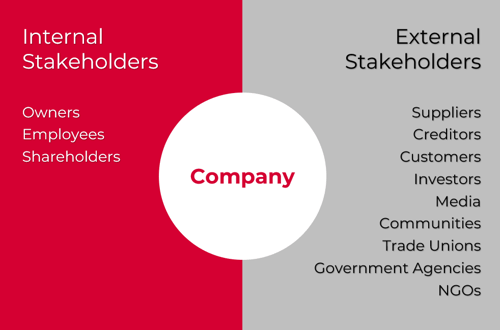Project stakeholders will always have an opinion and some sort of expectation towards a project.
And how you handle those stakeholder expectations can have a direct impact on the desired outcomes - which is why identifying and understanding expectations from the very beginning of your project or initiative journey is crucial in project management.
Let's go through the importance of managing expectations and the keys to doing so properly, so you can deliver value.
Firstly, why does managing stakeholder expectations matter?
It's not uncommon for stakeholders to not agree with or support projects. And while you might not be able to meet 100% of your stakeholders' needs and wants, it is essential to ensure their voice is heard and that you are carrying out an inclusive process.
By engaging with your stakeholders from the early stages of your project and managing their expectations along the way, you will see benefits:
- Conflicts and disputes can be promptly addressed or even avoided,
- Stakeholders will feel they're part of the process and will be more likely to be supportive,
- You will build trust, credibility and better relationships with your stakeholders,
- It will help you meet legal and regulatory requirements,
- And it ultimately will support a smoother journey and the success of your project.
How to identify stakeholder expectations?
Identify and map your stakeholders
In order to address expectations, you must first have a clear picture of who your stakeholders are. Who's going to be impacted or have an interest/impact on your project? Are they internal and/or external stakeholders?

You will identify a variety of stakeholders, from your project team to local communities.
Categorise your stakeholders and conduct a stakeholder mapping process so you can learn about the different interests of each one of them.
You will find that some stakeholders will expect to be highly engaged, while others may want to simply be informed periodically. You can use the interest/influence matrix to map and group your stakeholders (or any other criteria that are relevant to your project).
Working with a stakeholder mapping tool in this step can really help speed up this process and make it more accurate.
Plan your stakeholder engagement strategy
Create a stakeholder engagement plan to communicate with your stakeholders on a regular basis and tailor your strategy to each group.
Encourage two-way communication - your stakeholders can not only offer valuable feedback for your project but you can also get a sense of their perspectives (and their expectations).
Consider using tools where you can send out communication, track responses, record all feedback and analyse sentiment in a centralised manner. SRM systems are able to do all of that and help you make sure no stakeholder group is left unengaged.
Managing stakeholder expectations
Managing expectations is an ongoing process throughout the project lifecycle.
It involves communicating, listening to your stakeholders, and showing them that sometimes the outcomes are not exactly what they wanted, but that they are an active (and important) part of the process.
Here are 5 keys to managing expectations effectively:
Make sure your stakeholders know what project success will look like
Have a clear understanding of your organisation's goals and the expected outcome of your project - and that's before it starts.
If the project begins without a defined scope, that will make it difficult to explain the desired outcomes to your stakeholders and therefore to obtain their buy-in.
Involve stakeholders in the decision-making process
Engage with your stakeholders from the beginning and ask for their input. You want to try and keep their expectations aligned with your organisation's capabilities and limitations.
As mentioned before, providing stakeholders with regular updates and feedback throughout the project will help set more realistic expectations.
Have the levels and frequency of engagement clearly defined
It's essential to determine the engagement levels in your stakeholder engagement plan. Who needs to be informed, consulted and who requires collaborating with?
You want to work efficiently while keeping all the different stakeholder groups happy. And that entails knowing exactly how much engagement each group needs.
Seek to provide value regularly to your stakeholders, don't make them wait for it. You don't want to lose their attention and interest. Share relevant information at short intervals to keep them engaged, especially for long projects where patience is highly required.
Negotiate expectations
Even after keeping all your stakeholders in the loop and including them in your process, you still may have to manage conflicting or unrealistic expectations. It can be that your stakeholder's perception of the project is not aligned with reality or they can be stakeholders who are more difficult or challenging.
Listen to them and negotiate with them to find a mutually acceptable solution, and be willing to compromise. Focus on the underlying needs and interests of your stakeholders, rather than their positions or demands.
By striving to understand their side, you can find creative solutions that meet both your project's goals and the needs of your stakeholders.
Record all stakeholder activity
Keeping records of all stakeholder engagement activities is the best way to manage project expectations with success.
By recording all information, issues and changes you can prevent undesirable situations, such as leaving stakeholders without a response after making a complaint or forgetting to send that high-influence stakeholder the information requested.
It helps you keep all your project team on the same page. They can easily check who is engaging with who, what's being said and all the communication that's being sent.
And it also allows you to analyse all engagements made and assess your performance, so you can improve your strategies.
Streamline your stakeholder management
A proper stakeholder management & engagement system like Tractivity can help you better manage stakeholder expectations and work on your stakeholder engagement activities more effectively.
Explore Tractivity's features or contact us to book a free, personalised demo to see it in action at your convenience.


